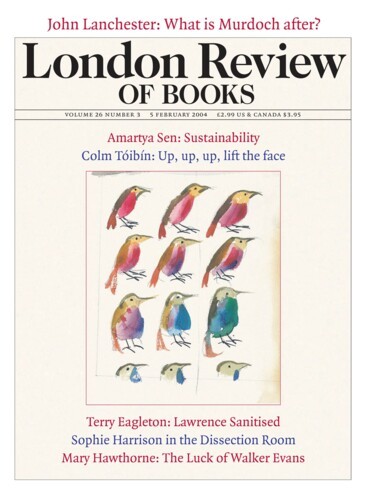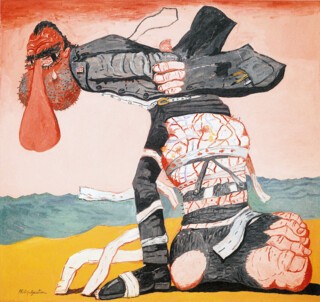As good a picture as any on which to hang thoughts about Philip Guston is San Clemente, painted in 1975. It shows Richard Nixon on the Californian shore. His pink, phallic nose droops between gross, grey, stubbled testicular cheeks. A tear runs down one of them. Bloodshot eyes swivel from under a black hedge of eyebrow. He looks back and down towards his enlarged, veined, pustular, phlebitic left leg. A grey, blood-stained bandage winds round it. The foot has burst through its sock. His coat tails flap behind him. A tiny American flag shines in his buttonhole. In the picture the cruel, coarse and energetic are melded with the monumental – as though one of Picasso’s neoclassical girls-on-the-beach scenes had been taken over by one of Gillray’s grossest caricatures.
San Clemente stands as a link between the first and last of three frames into which Guston’s work naturally settles. The first is 1930s left-wing rhetorical social realism – Guston painted murals under the influence of Rivera and Siqueiros. There is a photograph in the catalogue* of Guston and Reuben Kadish dwarfed by the bound victim, chains and giant symbolic figures of The Struggle against Terror, which they painted in Morelia, Mexico in 1934.
The third frame, which was not more than implied at the time San Clemente was painted, is that of American post-abstract figuration: not the cool, ironic Pop art figuration of Lichtenstein or Rosenquist, but the raw, scrawled attacks on pictorial propriety of, say, Schnabel and Basquiat, whose images could be more easily related to child art or graffiti than gallery art, and whose reputations would depend hardly at all on the critical exegesis which supported the rise of Abstract Expressionism. So while the political directness of San Clemente points backwards, its calculatedly unlovely brushwork points well forward. It is not surprising that the response to the 1970 exhibition of crudely drawn, thing-dominated paintings in which the San Clemente manner first appeared was negative. In pictures like The Studio, in which an artist in a Ku Klux Klan hood sits among paint pots and studio paraphernalia, a cigarette emerging from a slit in his mask, and paints a figure in an identical hood, Guston was pissing in the chalice, challenging the belief that the first wave of abstractionists would naturally be followed by a second and a third (each perhaps more refined, more minimal than the one before). That it was Guston doing the dirt was particularly offensive. The abstract paintings he had been doing until then were, very often, lovely things – among the most beautiful and luxurious of all the pictures produced by the New York School. The new ones seemed like a calculated fouling of the nest by a favourite child.
So the second explanatory frame – the frame which accommodates the abstract paintings of Guston and other members of the New York School – has little in common with the other two. Within that frame the thesis advanced was that the painted surface, the picture as thing not the picture as representation, was at the heart of aesthetic experience. In most of the mature work of Pollock (he was at high school with Guston), Rothko, Kline and Motherwell, and in Guston’s own abstract work, any vestige of figuration is in the eye of the beholder. De Kooning, who let swooping parkways and fierce women emerge out of a skein of brush strokes, liked Guston’s new pictures. Harold Rosenberg praised them in the New Yorker. But Hilton Kramer’s New York Times notice was headed ‘A Mandarin Pretending to be a Stumblebum’, and if the painters had read Guston’s 1970 notebook the betrayal would have seemed complete. In an entry made at the time of the exhibition he wrote: ‘American abstract art is a lie, a sham, a cover-up for a poverty of spirit. A mask to mask the fear of revealing oneself. A lie to cover up how bad one can be . . . It is an escape from the true feelings we have, from the raw primitive feelings about the world – and us in it.’
So, in the Guston exhibition at the Royal Academy (until 12 April), you can follow, in the work of one man, the dialectic of American painting as it was argued out during much of the 20th century. You start with European influences: a Mother and Child of 1930, surrounded by a de Chirico-like stage set, fighting children in The Gladiators of 1938 and Martial Memory of 1941, both of which have absorbed European formalism – Picasso perhaps – but at second or third hand. From the very beginning an American way of seeing things is also evident: the pneumatic modelling of the mother’s leg and shoulder brings Thomas Hart Benton’s ruralist mannerism to mind; the fighting children fit with what Ben Shahn was doing at the same time. The material – urban America and its inhabitants – also gives it a distinct, American flavour.
By 1947 the drawing regains a childlike directness. The painted lines take on the wiggles of a hand which is discovering each move for itself, not doing sweeping strokes on auto. Then, by the 1950s, there are the abstract paintings. As the decade advanced, they become so pretty and painterly that someone had to invent the term ‘Abstract Impressionism’. There was no way of looking at them without Monet coming to mind: down to the grated-carrot-like brush strokes and the way solid areas fade into pale ones.
Pictures like these cannot tell stories. The odd title (Beggar’s Joys) is suggestive, but the difficulty of finding explanatory words which are not vacuous is obvious. Claustrophobia begins to advance. Photographs of artists at work in their New York lofts, surrounded by big, painterly abstract pictures suggest lives in which self-reference has become burdensome. As time passed both Guston and Rothko started to paint darker pictures. In photographs of Monet at work on the Nymphéas in his vast studio at Giverny the nearby reality which is the source of what he is painting is implied. The artist is mastering the look of the world. In similarly large spaces in New York the landscape being mastered is in the artist’s head, something which must grow from feelings about colours and marks which leave big questions – is this happy? is it sad? is it clever? – for the viewer. The paintings can please or fail to please, but they cannot shock because there is nothing in them to argue about. You can see why Guston said that they were ‘an escape from the true feelings we have, from the raw primitive feelings about the world – and us in it’. You can see why he wanted out, and why his new pictures were shocking.
So one is back in frame three. After a little while you begin to notice things taken from pictures done decades back. The politics in San Clemente. The nailed boot. The Klan mask which appears in a drawing of 1930 for Conspirators: one hooded figure holds a rope, a group are gathered around a hanging man and a crucifix – when he was ten Guston found the body of his father, who’d hanged himself. The sticks the fighting children brandish in The Gladiators reappear too. But most of all you are reminded of comic books, comic strips, the funnies – Krazy Kat, Mutt and Jeff. Guston admitted that he knew them well – when he was 13 his mother enrolled him in a correspondence course from the Cleveland School of Cartooning – but he didn’t much care for the comparison. Robert Crumb, in his comic book Weirdo No. 7, which makes play with some of Guston’s motifs (the big eye, the soles of nailed boots) and has a narrative, ‘Uncle Bob’s Midlife Crisis’, in which he muses about taking up ‘a fine art career, oil painting maybe’, might have been suggesting that Guston was a plagiarist. The dates don’t fit. But the high art/low art antagonism can’t be ignored. When Guston took off the abstract mask, he lost the fear of revealing ‘how bad one can be’ and the images he made were done in a style only the true, deep tastelessness of someone like Crumb had, until then, had a use for. Guston can make his shoes, hairy knees and hairy arms, mugs, hands and dogs monumental, but the pictures are still rude, and rude is always in some way or another funny. A catalogue essay by Dore Ashton details Guston’s response to a vast range of literature – mainly European – and in particular his search for accounts of the working of the imagination which tallied with his own experience. This is not uninteresting, but in the end the work must stand on its own. The cultivated reader is shouted down by his big rude pictures.
Send Letters To:
The Editor
London Review of Books,
28 Little Russell Street
London, WC1A 2HN
letters@lrb.co.uk
Please include name, address, and a telephone number.


